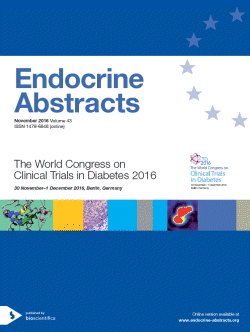Abstract Topics
Translational and Preclinical Trend in Diabetes
ea0043oc54 | Translational and Preclinical Trend in Diabetes | WCTD2016
Insomnia in adults with Type 2 diabetes: Baseline data from the Diabetes Sleep Treatment Trial
Chasens Eileen R. , Burke Lora E. , Baniak Lynn M. , Sereika Susan M. , Atwood Charles , Strollo Patrick J. , Korytkowski Mary
ea0043oc55 | Translational and Preclinical Trend in Diabetes | WCTD2016
“Energetic balance” appreciation as a complementary feedback for insulin delivery monitoring in glucose metabolism disorders
Coulic Very , Novikov VK , Iu Anisimov , Devriendt J , Dmitriev T
ea0043oc56 | Translational and Preclinical Trend in Diabetes | WCTD2016
The use of modified hyperinsulinemic hypoglycaemic glucose clamp to evaluate the accuracy of blood glucose monitoring systems in T1DM patients
Fawkes Neil , Fawkes Neil , Bell David , Bell Patrick
ea0043oc57 | Translational and Preclinical Trend in Diabetes | WCTD2016
Variation in arch index and subtalar joint range of motion in diabetic and non-diabetic conditions with and without neuropathy
Ibeneme Sam , Onyeje Uche , Ibeneme Georgian , Okoye Ifeoma , Fortwengel Gerhard
ea0043oc58 | Translational and Preclinical Trend in Diabetes | WCTD2016
ALMS1 acts as a critical molecular switch that controls Insulin-stimulated glucose transport in adipocytes
Licona Cynthia , Obringer Cathy , Rajapaksha Harinda , Dollfus Helene , Petrovsky Nikolai , Marion Vincent
ea0043oc59 | Translational and Preclinical Trend in Diabetes | WCTD2016
Human cartilage glycoprotein39 (HC-gp39) stands up for “Madam Diabetes”-a peasant French Woman: An update
ea0043oc60 | Translational and Preclinical Trend in Diabetes | WCTD2016
Glucose transporters and C peptide role in diabetes control a preclinical review of literature
Pham Thuy , Dao Marvin , Singh Mukunda




